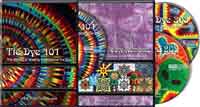Affiliate link

"Learn How to Tie Dye"
complete 3-DVD set
Order directly from
True Tie Dye
(international orders, too!)
or click here to order from Amazon
You are here: Home > All About Hand Dyeing > FAQ > Fixing Non-reactive Dyes > How can I tie dye with RIT® dye?
Affiliate link

Are you sure that's what you want to do?
If you want brightly dyed cotton shirts, you should always use fiber reactive dye, rather than all-purpose dye. All-purpose dyes, such as Rit® Tint And Dye, Tintex® High Temp Dye, and other brands, can never be as bright or long-lasting as fiber reactive dyes, when used on cotton or other cellulose fibers.
Rit® brand dye, like all brands of all-purpose dye, is a mixture of two kinds of dyes - an acid dye, which will just wash out of cotton, since acid dyes work only on animal fibers such as wool, or on nylon (but not on other synthetics) - and a direct dye, which is duller in color and bleeds a bit with every single washing, forever, unless a mail-order permanent dye fixative such as Retayne® is applied.
This is a fine idea for nylon fabric, though! The acid dyes in all-purpose dye are more satisfactory than the cotton dye in all-purpose dye, and acid dye can usually dye nylon.
advertisements
Rit Tie-dye Kit
All-purpose tie dye kits do not work as well as other kits.
All-purpose dye
fades quickly in the
wash, compared to
fiber reactive dye.
Acid Dye:
the best choice for dyeing wool or nylon, and works great on silk, too
All-purpose dye requires a completely different recipe from fiber reactive dyes. Do not follow the recipes found elsewhere on this web site! They work only with fiber reactive dye.
All forms of all-purpose dye, including Rit® Tint and Dye, Tintex® High Temp Dye, DEKA L® Hot Water Dye, and Dylon® Multi-Purpose Dye, require a considerable amount of moist heat to attach to fabric. This means that the usual tie-dye squirt bottle technique is right out: it simply will not work properly. For instructions, see the Rit Dye web site - but be sure to first acquire some Retayne® or a similar product to make the color permanent! (See below.) Instructions are also given below, as the Rit® web site was unavailable for most of 2002. They are much more cumbersome than using fiber reactive dye, but if you insist on using all-purpose dye, you'll be far better off using the correct instructions:
(Are you sure you wouldn't rather use cold water fiber reactive dyes, with the safe, quick, easy squirt bottle technique?)
Alternatively, you may apply your all-purpose or direct dye mixed with a small amount of water, allow to dry, then wrap in unprinted newsprint and steam your shirt over boiling water for half an hour or longer (after the water comes to a boil), in a covered pot, just as you would steam vegetables. Do not bake or use other dry forms of heat; dye requires the presence of moisture in order to bond to fiber. Note that even after heat-setting, both all-purpose dye and direct dye will tend to fade badly in the wash unless finished with a cationic dye fixative such as Retayne. Note that some color bleeding is inevitable in the first rinsing and during the Retayne treatment, if the dye is not sufficiently set; it is difficult or impossible to get truly bright results with contrasting colors, when tie-dyeing with all-purpose dye. For the brightest and clearest results, always use fiber reactive dye for tie-dyeing.
After dyeing with all-purpose dye, be sure to finish your dyeing by applying a product to prevent it from running with every wash. Such products include Retayne®, Dharma Dye Fixative®, and Aljo Pro-fix PCD® after-treatment. These products are sometimes available at your local quilting supply store, but usually must be purchased by mail; see Sources for Supplies. Retayne® is a cationic bulking agent that essentially glues the dye into the fiber, making the washfastness of even direct dyes quite acceptable after it is applied.
 see more answers to dye FAQs
see more answers to dye FAQs
All of the pages on this site are copyright ©1998‑2026 Paula E. Burch, Ph.D.
Last updated: July 29, 2008
Page created: August 8, 2002
Downloaded: Tuesday, January 06, 2026